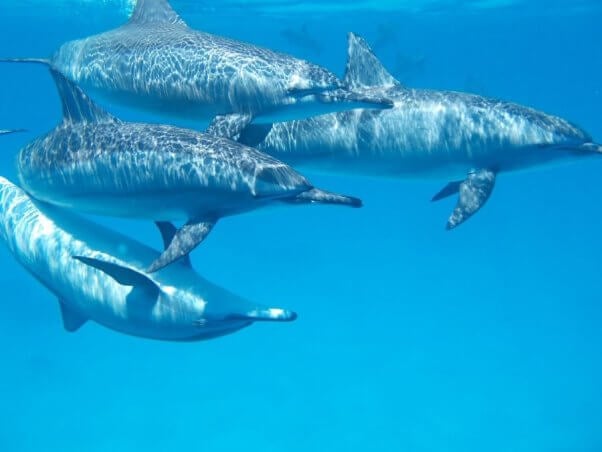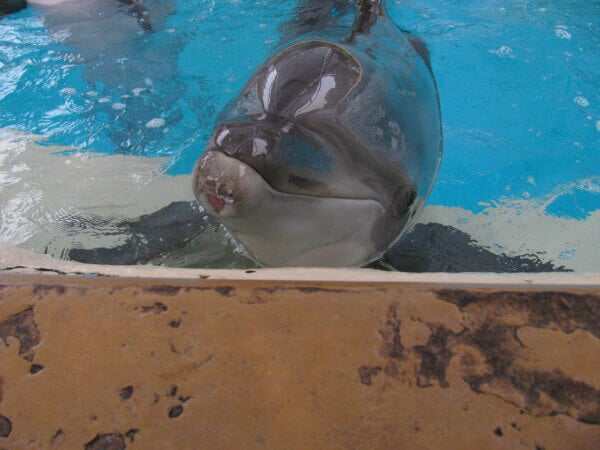UPDATE: Causes of Death Revealed for Dolphins at Florida’s Gulf World Marine Park
Three dolphins—Gus, Turk, and Nate —have died within a month of each other at Gulf World Marine Park in Florida. These sensitive, social animals spent their entire lives imprisoned in marine parks and never got to experience a life free from human exploitation.
How Did Three Dolphins Die in a Month at Gulf World?
Reports have confirmed that Gus was euthanized due to a “life-threatening condition,” and Turk succumbed to a bacterial lung disease. Fungal and bacterial infections are common causes of death for dolphins at marine parks, as the stress of constant confinement and exploitation may compromise their immune systems. Nate’s cause of death remains unknown.
Who Were Gus, Turk, and Nate?
Gus, Turk, and Nate were young bottlenose dolphins captive-bred at United Parks & Resorts’ abusement parks. Gus and Turk were born at SeaWorld Orlando, and Nate was born at Discovery Cove.
Learn more about SeaWorld’s sordid breeding program.
Marine parks deprived these dolphins of a natural life, forced them to perform demeaning tricks, and confined them to tiny tanks, where they likely swam in endless circles. In 2014, SeaWorld transferred Nate to Gulf World Marine Park, and the company sent Gus and Turk there in 2015.
In nature, they may have lived for up to 40 years—but none made it past 20 years old.
Did Gulf World’s Failures Cause Dolphins to Sustain Injuries?
Damning U.S. Department of Agriculture inspections over the last year have noted Gulf World’s dilapidated conditions. A July 2024 U.S. Department of Agriculture inspection report noted that the park had rust dripping into the main sea lion stadium pool, paint chipping off walls, and cracked concrete on the stage where dolphins slide out during shows. Previously, an October 2023 report by the agency noted that there had been at least one incident in which a piece of concrete was found in a dolphin’s mouth.
Several dolphins held captive at Gulf World, including Gus, Turk, and Nate, were prescribed eye medicine for a condition that could have been caused by direct and harmful exposure to the sun.
Federal authorities cited Gulf World for having its dolphin tanks dangerously unprotected from sunlight in July 2024, so it’s no surprise that dolphins there developed eye conditions—and perhaps other problems—from the park’s dangerous disregard for their care.
They Have No Chance of Escape
Open waters don’t need costly, precise treatments, repairs, and audits to sustain life.

In their natural habitat, dolphins don’t need “enrichment” and drugs to keep them from going insane because of stress and frustration. They flourish, exploring with their families, forming long-lasting friendships, and swimming up to 60 miles daily because it’s their home.
Animals imprisoned in marine parks, on the other hand, frequently develop chronic health issues because of their confinement.

Dolphins’ survival at marine parks hangs on a razor’s edge. Their lives as prisoners depend on human whims. They can’t swim away from tiny enclosures with rusty nails, high chlorine levels, cracked concrete, incompatible tankmates, or other dangers.
The Dolphin Company Cannot Be Trusted
Gulf World is owned by The Dolphin Company, which also runs the failing Miami Seaquarium, where the orca Lolita was confined and died before being released into a seaside sanctuary.
Miami-Dade County is currently evicting Miami Seaquarium after decades of horrific failures to care for the animals it imprisons, including underfeeding them as punishment, allowing facilities to crumble, and ignoring veterinary instructions.
Whatever You Do, Don’t Visit Marine Parks
The constant misery at marine parks around the world makes it clear: Dolphins, whales, and other marine mammals belong in natural settings.
There are no “humane” marine parks, because the premise of these facilities fundamentally deprives animals of everything that’s natural and important to them for human entertainment.
The best we can offer the dolphins and whales at marine parks today is transfer to seaside sanctuaries, which would give them a vast natural environment away from tiny concrete tanks, noisy crowds, and the other terrors of marine parks.
You Can Help Dolphins Today
Never go to Gulf World Marine Park or any other venue that exploits dolphins and whales, and explain to your friends and family why they shouldn’t support these businesses, either.
Then, urge SeaWorld to transfer the dolphins and whales it confines to seaside sanctuaries, where they could live in peace:

